Research
Mississippi Agricultural & Forestry Experiment Station | Publications
A Canopy of Color
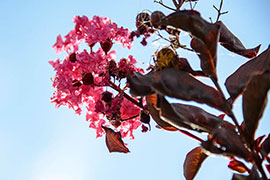
The process to develop a new crape myrtle cultivar takes a good bit of time. In the Mississippi Agricultural and Forestry Experiment Station, it begins at the McNeill Research Unit in south Mississippi. There some 3,600 crape myrtles are grown in a three-acre block with hopes of finding the next unusual or unique specimen. Knight has introduced five new crape myrtle varieties in recent months. All given Native American names with most having some Mississippi connection, it is hoped the trees will soon be licensed to a wholesaler for propagation and distribution. The five varieties include: Sequoyah, a unique clear red flower; Tishomingo, a clear medium to dark purple flower; Neshoba, a deep purple flower; Pascagoula, a deep purple flower; and Shumaka, a light pink flower.
Read More
A Leg-up with Legumes
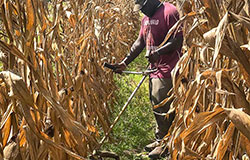
When corn is planted and thus harvested earlier, the cover crops in the system must be planted earlier for producers to reap the environmental benefits. While traditional winter legumes don't work with the timing of early-planted corn, heat-tolerant legumes should, and with that in mind, MAFES researchers set out to selectively breed winter legume cover crop species for heat tolerance to be used in an early-planted corn system. By the end of a three-year period, they found their stock of legume species to be between 70 and 99 percent heat tolerant, allowing them to be used in warmer weather and earlier planting cycles.
Read More
A Sweet Specialty
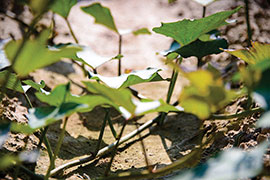
The economic impact of sweet potatoes in the state of Mississippi grew exponentially in 2015. Sweet potatoes stretched across 21,500 acres of Mississippi fields and generated $81 million in value of production, up 19 percent from 2014. Despite the growth, sweet potatoes are still considered a minor crop and as such, fewer research dollars are allocated to sweet potato research. MSU researchers are hoping to change that. MAFES scientists are researching different management practices to determine the most efficient and effective way to produce sweet potatoes. Research includes shortening the plant-back interval—or in other words, the amount of time you have to wait after a herbicide application before you can transplant sweet potatoes without injuring the crop. A lengthy plant-back interval will cause a farmer to lose out on the time they could have plants in the ground or prevent a herbicide from being available for use as a weed management tool. Scientists are evaluating sweet potato tolerance to several herbicides with long plant-back intervals in order to determine the level of risk associated with using these products in weed management systems. Recently, scientists also started producing virus-indexed heirloom varieties for home and niche growers. The goal is to eventually clean up everyone's sweet potatoes. Providing heirloom varieties is a way for to give back to the public as well as do some outreach about clean stock sources.
Read More
A Window of Time
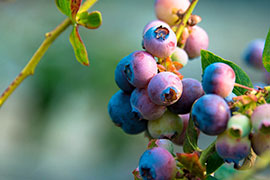
Timing is everything and for blueberry growers, the ability to harvest high-value fruit in the off season could reap financial rewards. Dr. Guihong Bi, plant and soil sciences research professor in the Mississippi Agricultural and Forestry Experiment Station, is currently evaluating organic and conventional blueberries grown in high tunnels. Those first fruits bear a premium price at market. There are 2,500 acres of blueberries in Mississippi that generate $8 million dollars annually. Production typically occurs south of Interstate 20 because of colder winters in the northern half of the state. Additionally, growers who go to market during the typical summer months don't get a premium for their crop. With high tunnels, growers have the potential to gain an edge on the market by having their berries ripen early by a month or more. Currently, there is no information available on containerized organic blueberry production in high tunnels in Mississippi. We are hoping to change that. The team is comparing organic and conventional production of ten early ripening cultivars. They are assessing the yield and the quality of each cultivar and chemically analyzing the fruit for antioxidant content.
Read More
Balancing the Benefits

Despite the growing trend of conservation practices such as the use of cover crops cropping up around agriculture, Midsouth producers have been hesitant over how the use of cover crops might impact their bottom line. Researchers at MAFES partnered with USDA-ARS on a long-term study to determine if and how cover crops can impact a grower's bottom line. So far, they have found that a reduced tillage system with subsoiling did not negatively impact yield, net return or water use efficiency. However, by replacing subsoiling with a cover crop in a reduced tillage system all of these measures were negatively impacted, and in a zone tillage system, neither subsoiling nor cover crops had a negative impact on these things.
Read More
Best Turf for Cemetery Use

MAFES researchers found it takes a special kind of turf to keep a cemetery looking nice without frequent maintenance. Researchers planted St. Augustine grass, centipede grass, zoysia grass, bermuda grass and Mississippi Supreme, an ultra-dwarf bermuda grass. They examined each turf for performance in Mississippi's climate, mowing requirements and ability to compete with weeds without regular fertilizer applications. It is estimated that the state has more than 3,000 acres of cemeteries with a wide range of costs to maintain turf. Cost is not the only challenge in cemetery turf maintenance; weeds and turf establishment also present obstacles. Weeds are a challenge to all lawns in the state, and cemeteries are no exception.
Read More
Cash, Cover, and Repeat
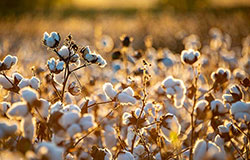
Researchers at MAFES established the Centennial Rotation in 2004 to understand and demonstrate the effectiveness of crop rotation. In the Centennial Rotation, the scientists have shown the potential to gain yields when cotton follows corn, increasing yields by 18 to 20 percent per acre each year. Now they are introducing cover crops to continuous cotton to determine if cover crops can provide the same crop rotation effect. They are also embarking on a separate study to introduce a cover crop that could also be a cash crop, such as canola. While the research is just beginning, the scientists at MAFES anticipate being able to answer questions regarding cover crops in rotation and in continuous cotton.
Read More
Conservation Cash
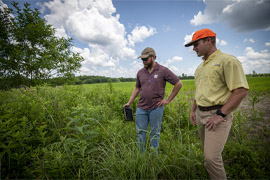
Dr. Mark McConnell, assistant professor in the Department of Wildlife, Fisheries and Aquaculture in the College of Forest Resources and scientist with MAFES and the Forest and Wildlife Research Center, along with Dr. Wes Burger, dean of the College of Forest Resources and director of the Forest and Wildlife Research Center, have launched the MSU Precision Conservation Tool, a decision-making software that identifies precise locations where conservation practices are most economically beneficial to farmers on specific tracts of land.
Read More
Conserving Mississippi's Water Resources
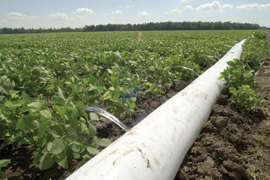
MAFES scientists Jason Krutz, Tom Eubank, Lyle Pringle, and Joe Massey are testing several water-saving strategies, including a computer program that calculates the performance and improves the efficiency of furrow-irrigation systems. In ongoing field tests, the Pipe Hole and Universal Crown Evaluation Tool (PHAUCET) demonstrated the potential to reduce the amount of water pumped from the Delta's underground aquifer. Preliminary results showed that the PHAUCET program reduces pumping times and water use by about 20 percent.MAFES scientists are also working with Mississippi rice growers to determine the potential for using the Asian technique of intermittent flooding. Mississippi farmers flood their rice fields and then let the water levels naturally subside. When the upper half of a paddy has drained, they pump back enough water to reflood the entire field. However, leaving the floodwater at a lower level allows the paddy to better capture rainfall. For every inch of groundwater that does not have to be pumped, farmers save about a gallon of diesel fuel per acre. To date, intermittently flooded fields have produced the same or better rice yields as traditional fields, and milling quality has been unaffected.
Read More
Cover and Compare
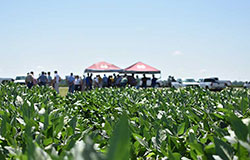
There are plenty of agronomic and economic factors to consider when producers decide to implement cover crops into their operation, so researchers at MAFES are trying to quantify the benefits of cover crops across six sites in the Mississippi Delta. They are evaluating soil health and water quality while building an economic tool producers can use to quantify the short-term economic costs and benefits of implementing cover crops. They plan to put all this information into a detailed, long-term model to demonstrate the long-term benefits of using cover crops and provide farmers with the tools necessary to be best informed.
Read More
Cultivating Sunflowers for Energy Production
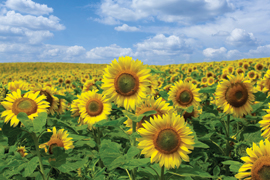
Agronomist Normie Buehring has been testing his green thumb on sunflowers, a crop that has potential as a food and bioenergy crop that farmers can grow in Mississippi. At the North Mississippi Research and Extension Center in Verona, scientists set out to evaluate new hybrid sunflowers with shorter stems, about 3-4 feet tall. They later planted the sunflowers at four locations around Mississippi as far north as Verona and as far south as Newton. Yield and oil content were equivalent to sunflowers grown in the North, where the flowers are typically raised. However, the Mississippi-grown sunflower seeds contained higher concentrations of oleic acid than the original planting seed. The high oleic acid content would be good for high-quality cooking oil production. Seed production and oil content are also important for bioenergy production.
Curb Your Antagonism
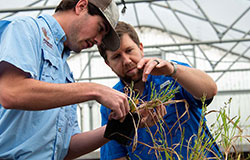
Plain and simple: plants fight for resources. In addition to eradicating weeds, producers must also fight common grasses that compete for vital nutrients. Oftentimes, this means using two different herbicides in soybean and cotton. Farmers use synthetic auxin technologies, like 2,4-D and dicamba, to wipe out broadleaf weeds and glyphosate to kill common grasses. For cost saving and convenience, producers often mix each of these herbicides in the spray tank, using the same spray lines and booms, so they can address both issues with a single pass across the field, saving time and fuel. This practice, however, often leads to herbicide antagonism, when one herbicide renders the other less effective. Researchers in the Mississippi Agricultural and Forestry Experiment Station hope to find application methods to curb this antagonism in a way that's effective, cost-efficient, and easy for growers to adopt.
Read More
Developing Better Cotton Varieties
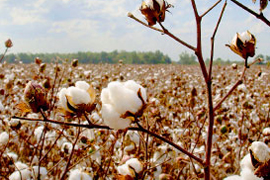
The USDA classifies plant-parasitic nematodes as one of the greatest threats to crops throughout the world. Nematodes alone or in combination with other soil microorganisms attack almost every part of a plant, including its roots, stems, leaves, fruit, and seeds. Associate professor Ted Wallace is working to develop nematode-resistant cotton cultivars. To date, he has selected breeding lines that show resistance to two of the most important nematode pests in cotton. Wallace has completed three growing seasons using marker-assisted selection and has evaluated more than 10,000 plants in search of a desirable combination of resistance, yield, and fiber quality. MAFES scientists have mapped the cotton genome in an effort to identify genes that code for beneficial traits in cotton, including pest resistance. The scientists are part of an international team that has described the first "gold-standard" genome sequence for Gossypium raimondii, the first cotton variety chosen for sequencing by worldwide cotton scientists. Identifying key cotton genes and their importance is a crucial step in developing improved varieties with greater yield, quality, and sustainability.
Energy from Grass
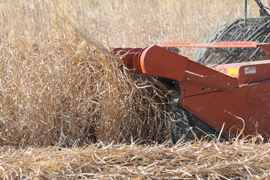
Scientists have identified a species of grassy feedstock that works well in sustainable bioenergy production. Giant miscanthus, a warm-season Asian grass, has potential as a biomass crop for fuel. MAFES scientists have isolated, identified and selected a genotype of the species that fits agricultural production systems of Southeastern farmers. This perennial plant offers several production advantages. It produces biomass that can grow as tall as 12 feet and thrives on marginal cropland. The crop is tolerant of drought and excessive rain, and it requires few inputs once established and maintained under a one-cut system. Giant miscanthus can be harvested and baled like hay using the same type of equipment.
Feeding a Hungry World
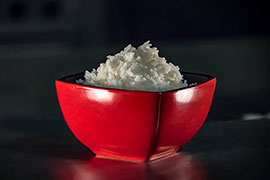
The MAFES rice breeding program, which has been developing high-yielding cultivars for the Midsouth for more than 30 years, helps Mississippi rice producers feed the world. The MAFES rice breeding program strives to produce high-yielding, disease-resistant, long-grain rice cultivars with a specific cereal chemistry and excellent milling quality. The program also seeks to understand the genetic basis of key traits for use in breeding and broadening the genetic base of Mississippi varieties. In recent years, the program has released popular varieties including Rex and Thad. Dr. Ed Redoña is the fourth rice breeder to serve at the program's helm and has been there since 2014. He said a single variety's release can have a big impact on the state's rice producers. "By 2013, the variety Rex already occupied 15 percent of the rice area in Mississippi, supplanting the most popular conventional variety in the state at the time. It yielded seven bushels per acre more than the previous variety, allowing growers to realize an additional $45 per acre. Based on 2013 market share and 2014 acreage, planting Rex increased annual cash receipts by $1.26 million, with an estimated annual statewide economic impact of $2.15 million," Redoña said.
Redoña said Thad, released in 2016, and its sister Clearfield variety, CL163, released in 2015, also show promise.
Read More
Forage Flyover
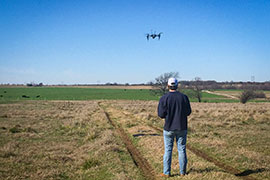
Dr. Garrett Street, associate professor in the Department of Wildlife, Fisheries, and Aquaculture and co-director of the Quantitative Ecology and Spatial Technologies Laboratory, Dr. Joby Czarnecki, an associate research professor in the MSU Geosystems Research Institute and MAFES scientist, and scientists in MAFES and the MSU Forest and Wildlife Research Center have collaborated to focus on using UAVs and accelerometers to better understand forages. The researchers aim to learn how forage quality and availability influence the long-term body quality and behavior of grazing animals, such as cattle, while remaining cost-effective. The team developed mathematical models that allow researchers to think about cattle behavior and movements affecting calorie intake and expenditure. Since 2019, they have been able to create models predicting forage characteristics like total fiber, crude protein, and nitrogen, and they produced maps giving fine-scale and accurate information about different aspects of forage quality that affect grazing systems. Researchers aim to have these models be universally applicable. By using drones and boots-on-the-ground methods of analyzing a landscape, the researchers can bridge the gap of information that would otherwise occur if using only one method. The products produced from this research will allow cattle producers to know how much forage is available in a pasture as well as the nutritional quality of that forage, decreasing the likelihood of overgrazing.
Read More
Fresh Local Flavor
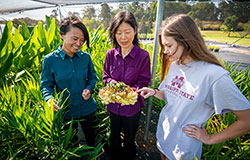
The U.S. is the largest importer and consumer of spices in volume and value according to the USDA. MAFES researchers are helping Mississippi's produce farmers diversify their crops and improve their crops while increasing availability of fresh herbs and spices grown locally. The team, led by Drs. Guihong Bi and Tongyin Li, is researching ways to help growers select cultivars of herbs and spices. They studied 12 basil, eight parsley, nine garlic, one ginger, and three turmeric varieties in containers and raised beds, evaluating growth habits, vigor, leaf color, size, and biomass. The team hopes to learn about vegetable crops that aren't widely grown in Mississippi to figure out if and how Mississippi producers can grow new offerings here. Besides trying to find alternative crops, they also want to explore alternative production practices to give growers options.
Read More
From Row Crop to Runway
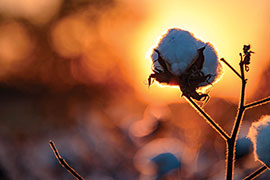
From the field to fabric, from row-crop to runway, cotton plays a pivotal role in dozens of industries. Scientists in the Mississippi Agriculture and Forestry Experiment from agronomists to geneticists to plant pathologists to economists to fashion design and merchandising experts conduct vital research and provide students the baseline they need no matter which way they choose to contribute to the massive footprint cotton has in the global marketplace. On the row-crop side of the equation, Mississippi State University is considered a leading research institution focused on a variety of topics centered on the plant itself. On the textile front, a popular online resource for students seeking information on fashion careers and academic programs ranked Mississippi State among the nation's Top 50 fashion design schools in 2016. In agronomy, research covers the gamut of cotton production—from seed to harvest. Projects evaluate seed treatments for plant growth development and yield with numerous treatments, nematode populations, and soil textures. In fashion, MAFES scientists are working to identify the factors that affect Mississippi's cotton industry's global competitiveness.
Read More
Fruit of the Vine

MAFES scientists, Dr. Eric Stafne and Dr. Sam Chang, are working to bring a sweet treat to Mississippi's farms. Fruits such as bunch grapes, muscadines, and blackberries, are native to the state, but have not had much success in large-scale production due to disease and harvesting difficulties. Stafne's main research has been evaluating bunch grape cultivars to see how they perform in Mississippi where there is an endemic disease called Pierce's disease (Xylella fastidiosa), which infects grapes via insect transmission. Blackberry growers also face challenges, in the form of pests and genetic disorders. As for muscadines, the biggest difficulty is in production cost. However, Dr. Sam Chang's research on the health benefits of muscadines suggests that it may be worth it. Compared to other grapes, muscadines are high in antioxidant properties, and they also have several other health benefits that could make it an up-and-coming superfood. Chang's next step will be determining which portions of the grape contain the highest concentrations of ellagic acid and antioxidants.
Read More
Head Strong
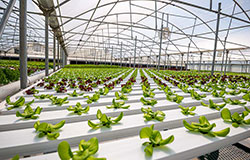
When a hydroponic vegetable producer in Mississippi noticed a decrease in yield, he reached out to MAFES scientists to help troubleshoot the issue. Hydroponics skip the soil and crops are grown in a nutrient-rich solution. While greenhouses can regulate temperature and moisture to some extent to allow for a year-round growing season, much still depends on external temperature and light. MAFES scientists set out to see if manipulating the electroconductivity—or concentration of mineral elements—of the nutrient solution during each season would combat those seasonal changes in temperature and moisture. The shift worked resulting in record yield.
Read More
Heed Change, Take Root
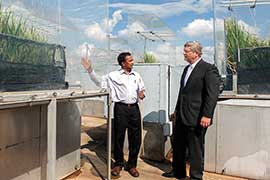
The anticipated climate change will increasingly impact crop production and food security in the coming years. K. Raja Reddy, Mississippi Agricultural and Forestry Experiment Station scientist and research professor in the Department of Plant and Soil Sciences, studies how environmental stressors impact crops. As director of the Soil-Plant-Atmosphere-Research, or SPAR, facility at MSU, Reddy focuses on environmental plant physiology, evaluating factors such as temperature, drought, solar radiation and nutrients. He studies a variety of crops including corn rice, soybeans, cotton, sweet potatoes, peppers and biofuel crops. The research, much of which is funded by the corn, soybean, rice and cotton promotion boards, focuses on giving producers the tools they need in a changing climate. As scientists evaluate hybrid tolerance to such environmental stressors as heat and drought, their research helps producers select the ideal variety based on tolerance and yield potential for that particular location. As climate changes, Reddy hopes to continue to provide information that will optimize production while minimizing loss to environmental stressors in the field.
Read More
In the Weeds
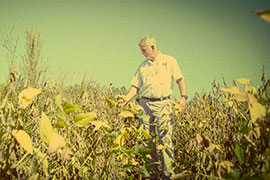
While palmer amaranth may look inconspicuous in its seedling stage, its impact on farmers is nothing short of shocking. In the absence of weed control, it could cause losses of up to $1.6 billion a year by overwhelming cotton, corn, and soybean fields. Traditionally it was fairly easy to manage: farmers could apply glyphosate, a herbicide that's been around forever, and it would kill the weeds, allowing the crops to flourish. In 2008, that shifted. Scientists documented the first population of glyphosate-resistant Palmer amaranth, meaning that the weed no longer succumbed to applications of the herbicide. This made it difficult to kill without resorting to extreme measures. MAFES scientist have confirmed resistance in weeds like Palmer amaranth, as well as to map out which biotypes are most resistant, and to test whether the weeds are resistant to other herbicides. They also evaluate the effectiveness of herbicides like glyphosate for control of weeds in the Mississippi Delta. While the ideal way would be to find a herbicide with a new mode of action—a new way of killing the plant—one hasn't been found in 20 years. Instead companies have opted to genetically modify plants so that they can withstand old herbicides—like 2,4-D and dicamba. Although this works well to control weeds, plants without the dicamba or 2,4-D tolerant trait are ultra-sensitive to these herbicides. Scientists are conducting research to help prevent off-target herbicide applications by evaluating new formulations that are less volatile and drift less, as well as finding ways to reduce tank contamination. While the new formulations don't guarantee other crops will be kept safe, they may be a step toward providing producers with a tool to fight herbicide-resistant weeds.
Read More
Irrigation Innovation
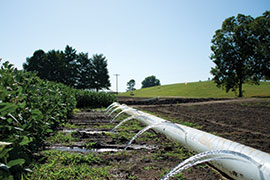
MSU scientists research essential tools and best practices to improve irrigation in the field. Pipe Hole and Universal Crown Evaluation Tool, or PHAUCET, surge valves and soil moisture sensors are three essential tools recommended by Jason Krutz, MAFES researcher and Extension irrigation specialist. PHAUCET is a computerized program that calculates the correct hole size and distribution for poly pipe to furrow irrigate row crops. Surge valves split the distribution of water in the field. Soil moisture sensors determine the amount of moisture in the soil profile. Additionally, the university engages in two dynamic research programs that cut down on the quantity of water used in irrigation while improving water quality overall. In MSU's Row-crop Irrigation Science and Extension Research, or RISER, program, scientists partner with growers to promote better irrigation management practices. In MSU's Research and Education to Advance Conservation and Habitat, or REACH, program, scientists introduce growers to innovative management practices for water use that save money without compromising yield. MSU scientists are also looking ahead at research opportunities involving intermittent flooding, polyacrylamide gel and surface water.
Read More
Let Go of My Legume
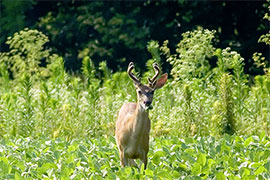
MAFES scientists, Dr. Te-Ming Paul Tseng, assistant professor in the College of Agriculture and Life Sciences' plant and soil sciences department, and Dr. Marcus Lashley, assistant professor in the College of Forest Resources' wildlife, fisheries and aquaculture department, have teamed up to use precision agricultural tools to protect soybeans from pests.
Soybeans are a well-known favorite of white-tailed deer, whose browsing during early plant establishment can damage yields. Traditional repellents, such as fencing or chemical repellents are expensive and ineffective. Instead of going the traditional route, Lashley and Tseng turned to nature for new ideas.
To find natural ways to combat pests, they turned to the forest ecosystem, and looked for plant species that pests tend to leave alone. They then extracted the compound that deterred animals from the plant, which they are now in the process of patenting.
"Our experiment is set up so that there are multiple layers of protection for the soybeans—in some treatments they are accessible to everything. In others, they are accessible to insects but not deer. And in the last treatment we have insect netting and exclusion fencing up, which will discourage all pests," Tseng said.
This set up will allow the researchers to record data on exactly how much each pest impacts soybean yields, and whether treatments of their compound dissuade both hoofed and winged pests.
Read More
No-till Farming Opens Hills to Crop Production
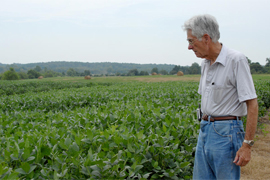
Time, experience and research findings show no-till farming can boost production, prevent soil erosion and transform hayfields and pastures into viable cropland. Producers who practice no-tillage grow crops without disturbing the soil except at planting, using any residue carried over from previous crops as mulch. Instead of tillage, earthworms and other soil organisms aerate the soil while preserving its structure. Today's surge in commodity prices has created an ideal time for producers to embrace no-till methods. No-till works particularly well on sloping land that is often passed over by buyers and renters looking for cropland acres. Land cost in the Hills is lower than in the Mississippi Delta, and one can easily farm with no-till practices on sloping land. These fields drain well and will support equipment much better than land that has been tilled, so producers can work more days than in a tilled system.
Read More
Outwitting Weeds
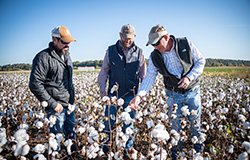
MAFES scientists are harnessing artificial intelligence for real-time integrated weed control. Drs. Wes Lowe, Daniel Chesser, and Brian Pieralisi conducted a study funded by Cotton Incorporated to determine the capabilities of artificial intelligence and automated mechanical technologies in weed detection and control. Weeds become herbicide resistant as a result of using the same herbicide for many years. While the tools available to farmers today are exclusively spraying or tilling systems, these scientists are working on a product that completes both simultaneously. The product they created was a John Deere 845 cultivator outfitted with Trimble WeedSeeker optical sensors to trigger hydraulically actuated tillage tines that plow the detected weed out of the soil. While the trials showed some limitations with the system, the team is tweaking a more precise optical system to better identify weeds by species and determine whether to till or spray. In addition to refining mechanical and technical components of their device, the team also hopes to develop a weed database to aid in machine learning for this technology and more.
Read More
Patio Tomatoes and Raised-bed Arugula
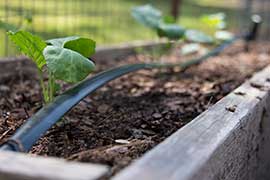
MAFES scientists Drs. Christine Coker and Gary Bachman have developed easy ways for
Mississippi residents to have a flourishing vegetable crop without actually having a traditional
garden.
Dr. Coker specializes in raised beds, which are garden beds installed above the ground, so that
no tilling is required. She sees the rising trends toward raised bed gardens and container
gardens as part of a larger local food movement, which encourages people to source their food
from their surrounding community.
Bachman is helping to address the same issues through his work on container gardening. In
particular, he's narrowed his research to containers designed to help beginner growers succeed with irrigation technology and helps hone in on the common problems that beginner gardeners
have. One of the best tools he's found for new gardeners are subirrigated containers such as
the EarthBox®, an affordable planter with a reservoir in the bottom to help plants stay properly
moist.
Experiments and tools like these have helped Coker and Bachman hone in on techniques that
homeowners can use to be most successful in growing their own food.
"I work with many people and families, and a lot of those folks have never gardened
before-and their parents have never gardened before-so it's multi-generational. Our idea is
to help them be successful on a small scale, so that they keep going," Bachman said.
Read More
Plenty of Ground to Cover
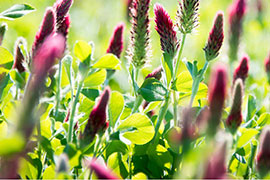
The idea that cover crops help aid in soil health is as old as the Mississippi hills. In fact, before commercial fertilizers were available, legume cover crops were a mainstay in the crop rotations of many Mississippi farmers. Cover crop research endures in the Mississippi Agricultural and Forestry Experiment Station. Researchers are exploring novel ways to utilize cover crops in the improvement of soil health and while cover crops aren't for every farmer in every field, the research indicates that cover crops offer benefits in certain situations. Current research includes determining ways to improve soil health through the use of cover crops and poultry litter. The research, which has been conducted over the past five years, is focused on quantifying fertilizer nitrogen equivalence from the application and utilization of poultry litter and cover crops. In low-end systems, the legume cover crop is recovering some of the nutrients from the poultry litter. Corn yields have increased the most in the system that include a legume and poultry litter. MAFES scientists are also focused on helping more than 1, 200 vegetable producers throughout Mississippi by studying the benefits of the cover crops vetch and rye in no-till vegetable production systems. Scientists in the Delta are researching whether specific tillage and cover crop practices will help solve the specific problem of crusting in silt loam soils. hese researchers are leveraging decades of knowledge and know-how in order to find innovative ways to utilize a system that has a long standing history in the Magnolia State.
Read More
Researchers Assess Plant Health for Nitrogen Prescription
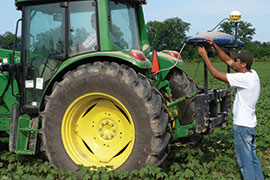
Determining the right amount of nitrogen for crops can be a challenge for Mississippi producers. If there isn't enough nitrogen, yield is sacrificed, while an excess amount can result in nutrient loss, which can negatively impact the crop and the environment. Achieving optimal efficiencies in nitrogen management is essential in decreasing costs while increasing environmental stewardship. MAFES scientist, Jac Varco, evaluates plants directly to determine nitrogen needs. He studies cotton and corn. Varco's team uses tractor-mounted sensors to measure relative differences in crop size, biomass, leaf area and plant greenness. The measurement helps researchers determine the right prescription of variable rate nitrogen that needs to be applied to the field. Research results indicate the sensor-based fertilization is capable of either decreasing the amount of nitrogen while maintaining yield or increasing yield with slightly more nitrogen.
Read More
Researchers Explore Early Corn Planting
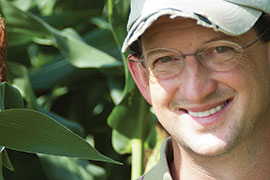
Timing counts for a lot when it comes to planting corn. That's why Mississippi State University scientists are researching the effects of planting date, plant population and hybrid selection for field corn. MAFES scientist Brien Henry studies how different hybrids and plant populations respond to the colder, wetter conditions of early planting. His work can gather information about environmental limitations, provide insight on optimal plant populations and explore avenues like whether certain hybrid traits will allow the crop to overcome the risks associated with early planning while reaping the benefits.
Read More
Researchers use Precision Agriculture for Weed Control and More
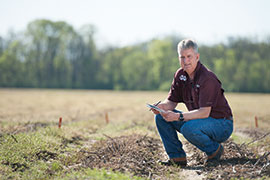
MSU scientists utilize precision agriculture in weed control and herbicide drift research. As Jason Bond, MAFES associate research professor at MSU's Delta Research and Extension Center, conducts and develops prescriptions to help farmers control weeds, MAFES scientist Dan Reynolds has several herbicide-related projects focused on improving production and reducing costs for farmers. Bond, along with other MSU researchers, developed a comprehensive herbicide program to manage glyphosate resistant Italian ryegrass. The prolific weed, resistant to the herbicide commonly known as Roundup, was first discovered in Mississippi and can be found throughout the state and in many states in the Southeast. The region looks to Mississippi to develop best practices for eradicating the weed. Reynolds and his team evaluate auxin technologies like dicamba and 2,4-D. In one recent study they evaluated the effect of drift reduction technology on soybeans injured with herbicide containing dicamba. The goal of the research is to provide an objective tool for recognizing and assessing drift injury from auxin herbicides at the field and landscape levels.
Read More
Rice Irrigation Method Saves Fuel, Water, Money
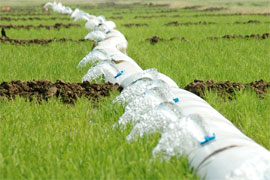
Ten years of research indicates that a water management strategy can save rice producers money on fuel and conserve water without hurting yields. Joe Massey, a scientist with the Mississippi Agricultural and Forestry Experiment Station and professor in Mississippi State University's Department of Plant and Soil Sciences, has focused his career on water conservation in agriculture. With funding from the Mississippi Rice Promotion Board and Mississippi Water Resources Research Institute, Massey worked with other MAFES researchers and rice growers to determine if intermittent flooding could work in Mississippi, as it does in Asia. Massey found that Mississippi farmers flood their rice fields and then let the floodwaters naturally subside. When saturated mud is exposed in the upper half of the paddy, they pump back to a full-flood depth of about four inches. Growers using this method might pump water onto their fields only every five to nine days, depending on weather and soil conditions. By allowing the water level in the paddies to decrease, growers can better capture rainfall. One grower using intermittent flooding in 2011 subjected his field to eight wetting and drying cycles, resulting in substantial savings of water and fuel. For every inch of rainwater that is captured or groundwater that is not pumped, farmers save about one gallon of diesel fuel per acre. For large operations, such savings can add up to tanker truckload quantities of fuel. Typically the Mississippi Delta gets 10 to 14 inches of rain during the growing season. If rice paddies are completely filled, there is no room to capture rainfall—it rains, and the water runs off. Runoff may carry away nutrients and other chemicals that are expensive to purchase, and it may also contaminate our streams and rivers. The study found that even partial adoption of intermittent flooding can save producers money on energy and can relieve stress on those producers who struggle to maintain their rice crop when other crops also need watering.
Read More
Robusto Covers Ground
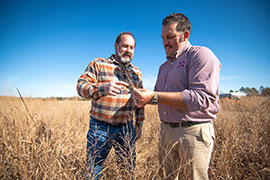
Drs. Brian Baldwin, Brett Rushing, and Jesse Morrison, all from the Department of Plant and Soil Sciences and scientists in the Mississippi State Agricultural and Forestry Experiment Station, have spent years breeding a high-germinating variety of switchgrass named 'Robusto,' and it is being prepared for the commercial market. The three's focus has been breeding varieties of native grasses that are adapted to the humid Southeast. The origins of 'Robusto' can be traced to the 20-year-old harvest from the Whitten Plant Materials Center in Coffeeville, Mississippi, whose living repository contained seeds from Mississippi, Arkansas, Louisiana, and Alabama. The team concedes that germination rates fluctuate with changes in environmental conditions, the rate of 'Robusto' maintained a range from 31.11 to 76.50 percent, which is the highest rate of any known improved variety of upland switchgrass. The MSU-bred seed is being prepared for release through Roundstone Seed, a Kentucky-based company.
Read More
Room to Graze
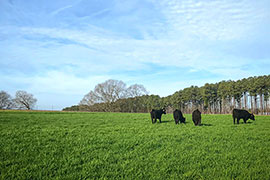
Dr. Brett Rushing, associate extension and research professor in plant and social sciences and Dr. Josh Maples, assistant professor and extension economist in agricultural economics, researched if combining cover crops with grazing cattle could improve both the grazing animals' weight and the producer's bottom line. Starting with this two-year study, the team established row crops and cover crops that encompassed a variety of species suitable for grazing that led to increased livestock weight gain. Using a no-till management approach and starting with oats, crimson clover, and radish as cover crop treatments, the researchers managed these cover crops along with the livestock that would eventually graze the crops. The team assessed three treatments to compare a tilled crop with grazed and non-grazed crops. Results showed that grazed crops were more successful with an increase in organic matter, and they found that some single species crops were more beneficial and successful than diverse mixes. The team is starting a new research project that will focus on cereal rye as the cover crop treatment along with evaluating soil benefits through a biological lens.
Read More
Rooting Out the Weeds
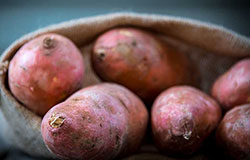
Because Mississippi is one of the nation's leading sweet potato producers and because sweet potatoes are highly susceptible to profit-slicing weeds, researchers at MAFES are working to identify weed-suppressive sweet potato cultivars and cover crop strategies that could enhance the profitability and adoption of organic sweet potato production. They've done a number of greenhouse and field screenings and are now breeding the most-suited cultivars in hopes of magnifying the weed-suppressant characteristic and provide Mississippi's sweet potato business a big boost.
Read More
Seeds of Hope
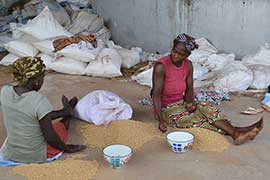
George Awuni understands food insecurity firsthand. A native of Ghana, in sub-Saharan Africa, Awuni has seen what the scarcity of food does to a community and a nation. He has known hunger and, even though, his mother worked to provide for the family, there were times when Awuni went to bed on an empty stomach. As a post-doctoral researcher in the Mississippi Agricultural and Forestry Experiment Station, Awuni, along with Dan Reynolds, the Edgar E. and Winifred B. Hartwig Endowed Chair in Soybean Agronomy, is working to enable small-scale Ghanaian farmers to share in the rising demand for soybeans in Ghana. The research includes collaboration between five institutions of higher learning and 10 governmental and non-governmental research partners.
Read More
Shades of Green
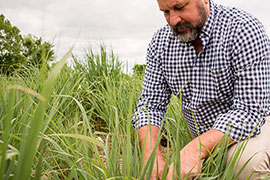
The uses of perennial warm-season grasses are as varied as the plants themselves. Applications include poultry bedding, cattle forage, conservation plantings, bioenergy, and much more. Scientists in the Mississippi Agricultural and Forestry Experiment Station have been propagating grasses as bioenergy crops since the early 2000s. Now as demand for renewable energy crops shift, MSU's perennial grass research evolves to meet other needs.
Read More
Soybean Innovation Laboratory
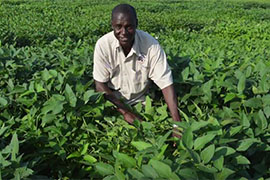
The Soybean Innovation Laboratory provides the science necessary to enable small producers to share in the rising demand for soybeans. The research also will enable low-resource countries to address problems of food insecurity and protein malnutrition. Mississippi State University's Agricultural and Forestry Experiment Station is among a consortium of universities and other partners receiving a $25 million, five-year international grant to boost soybean production across Africa. Mississippi State University is among a consortium of universities and other partners receiving a $25 million, five-year international grant to boost soybean production across Africa. The Feed the Future Innovation Laboratory for Soybean Value Chain Research, also known as the Soybean Innovation Laboratory (SIL), is being funded by the U.S. Agency for International Development.
Squeezing Energy from a Beet
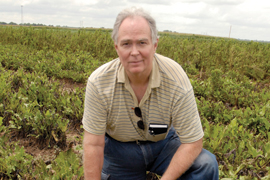
Energy beets could provide an off-season crop for Mississippi farmers and an alternative energy source for the nation's expanding biofuel industry. At the Delta Research and Extension Center in Stoneville, plant scientist Wayne Ebelhar and other researchers are examining the growth and profit potential for varieties of energy beet, a nonedible relative of the sugar beet used only in biofuel production. Because they are traditionally grown in much cooler climates, energy beets will grow best during Mississippi winters as a cover crop on fields between fall harvest and spring planting. MSU Extension agents are enlisting farmers willing to grow energy beets to test how well the crop grows in Mississippi and whether it can be produced at a profit. While energy beets are not a cheap crop to grow—about $700 per acre—the financial breakeven point would be yields around 20 tons per acre. Energy beets could yield as much as 50 tons per acre. After a few more years of testing, scientists are confident energy beets will make an excellent winter crop with minimal insect, disease, and weed pressure during the cold months.
Read More
Strawberry Yields Forever
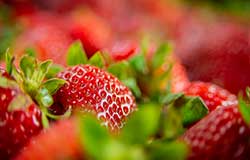
MAFES researchers are hard at work with the hopes of figuring out how to extend the strawberry season. By growing the fruit in high tunnels, researchers were able to extend the strawberry growing season by more than a month with improved fruit quality. Next, researchers plan to test the effects of various mulches, and should the results continue to bring strawberry harvest earlier and earlier, producers will continue with have an edge in an already-competitive market.
Read More
Studying Coastal Impact of Ecofriendly Green Roofs
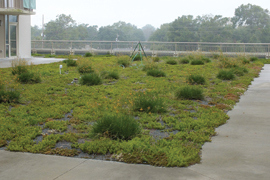
Horticulturists Christine Coker and Gary Bachman of the Coastal Research and Extension Center are studying and recording the effects of the coastal climate on eight "green roofs" at the Armed Forces Retirement Home in Gulfport. Green roofs are gardens planted in layers of specialized materials on properly reinforced rooftops. These green roofs sit atop the first floor and are visible from the veterans' apartments, which rise above in towers. The 78,000-square-foot green roof system was a requirement for the retirement home to be certified through the U.S. Green Building Council's Leadership in Energy and Environmental Design program. Certification measures, like installing green roofs, increase biodiversity and reduce energy consumption, erosion, and pollution. They also provide beautiful spaces for residents, staff, and visitors to enjoy. Coker and Bachman study how the coastal climate affects the microenvironments of green roofs. They gather data, such as median air temperature, humidity, moisture content of the plant medium, and saltwater spray exposure. Because limited data is available on green roofs in coastal areas, the project is expected to provide valuable insights on these types of ecosystems.
Read More
Success of a Seed
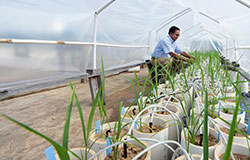
Though we often think of the fully-grown crop when considering agricultural commodities, there is also a profitable sector of agriculture that deals specifically with seeds. For this reason, MAFES scientists have been studying the effect of parental stress on the future development of soybean seeds in hopes of identifying the best areas and conditions for seed production. What they've found has consistently been that a parent crop's strain is handed down to the seeds and can be exacerbated to a detrimental degree by the seed's own environment. The team is also studying how seasonal growth in parent plants affects post-season seed germination and seedling growth in rice and are evaluating cultivars that can withstand temperature and moisture differences.
Read More
Sweet as Pie

Best management practices for blackberries are being investigated by MAFES scientists. Recognizing white drupelet disorder as an emerging issue in blackberries, Dr. Eric Stafne is conducting research to help producers and consumers alike. The disorder mainly occurs in the "Sweetie Pie" variety and can act as a significant hindrance for southern growers. While it does not harm the plant, the white color and slightly bitter aftertaste of an affected berry can discourage wholesalers and confuse consumers who may not know about the disorder. Stafne along with his doctoral student Haley Williams are investigating the causes of the disorder including genetic and environmental factors. The team conducted three treatments with varying degrees of nitrogen, which is essential to crop growth. Five applications of nitrogen lowered the disorder's presence from thirteen percent to nine percent. Stafne is optimistic that this management strategy will benefit producers and help consumers in the South have access to blackberries without this disorder.
Read More
Targeting Tomatoes
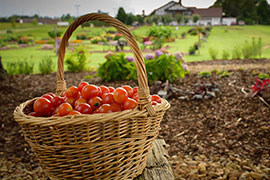
The most common garden vegetable is also a staple in research laboratories at Mississippi State. From herbicide tolerance to gene modification, tomatoes are being studied to help farmers grow the popular fruit with fewer losses or injuries to the plants. Dr. Sorina Popescu, MAFES assistant professor in biochemistry, molecular biology, entomology and plant pathology, is working to understand how tomato plants respond to pathogens at the molecular level, and editing the plants using CRISPR (clustered regularly interspaced short palindromic repeats) technology. Popescu explained that the technology allows her to silence a gene expression or make it louder, which affects the plant's response. The technique is promising, she said, because you don't bring anything new into the plant or take anything away. The pathogen Popescu is studying is called Pseudomonas syringae. It can easily wipe out an entire tomato crop if it infects the garden.The pathogen causes brown-black leaf spots and specks on green and red fruit. The pathogen causes stunting and yield loss, particularly if young plants are infected. Most pathogens have effectors that act in very similar ways. By studying tomatoes and Pseudomonas syringae, Popescu believes the findings can be extended to other vegetable crops to make them less susceptible to pathogens. Other tomato research happening at Mississippi State, though, may show noticeable improvements in the field more quickly. Dr. Paul Tseng, assistant MAFES professor in plant and soil sciences, is working on two research projects to get rid of the weeds growing in tomato crops. One of Tseng's research projects is to find herbicide-tolerant tomatoes that won't be affected by herbicide drift. His research started with 120 different varieties of tomatoes. So far, he has found 10 to 20 varieties that are tolerant to different herbicides. These varieties, though, are not necessarily commercially-produced tomatoes, and don't have the agronomic qualities like high yield and large fruit size that growers want. Tseng is also fighting the weeds directly through the allopathic traits in tomatoes. Allelopathy is the chemical inhibition of one plant by another, due to a release into the environment of substances acting as growth inhibitors. Allopathic tomatoes would release chemicals into the soil that interact with the roots and weeds and kill them. Both studies will help growers continue to provide one of summer's favorite fruits: red, ripe tomatoes.
Read More
Tea Time in Mississippi
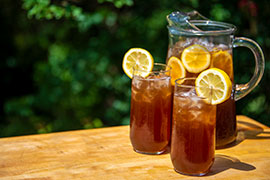
Today, iced tea makes up about 75 to 80 percent of tea consumption in the United States, with the country being the third leading importer of tea around the world. Despite its popularity, tea is not widely grown in the U.S. due to high production costs. MAFES researchers have been gathering and comparing various tea varieties in hopes of establishing cultivars that will prosper in Mississippi's agricultural environment and create a lucrative domestic economy for tea production.
Read More
The Maze of Maize
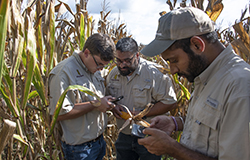
Sulfur is a key macronutrient required to grow a healthy crop of corn. Dr. Jagmandeep Dhillon leads a team of MSU researchers to determine how nitrogen affects sulfur levels in corn plants and vice versa. Sulfur deficiency has been an increasing problem for farmers since modern farming practices have developed, there have been changes in the air, and the lack of absorbance by plants. In an attempt to counteract the poor efficiency of this nutrient, consumption of sulfur-based fertilizer is increasing at a rate between three and five percent each year. The team aimed to evaluate optimal nitrogen and sulfur rates specifically for Mississippi corn production. Test sites were created with different rates of nitrogen and sulfur planted before the corn to collect data during the growing season. A predictive algorithm was created for each model and was used to predict sulfur deficiency. Dhillon plans to improve the algorithm predicting optimal fertilizer rates to produce the best possible crop yield.
Read More
The Need for Speed
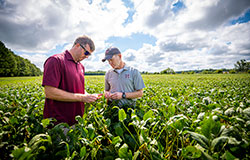
Brought to the United States from China in the eighteenth century, the soybean occupies 75 million acres of U.S. land today. In Mississippi, soybeans are the number one row crop and second largest agricultural commodity. In a study funded by the Mississippi Soybean Promotion Board, a team of MAFES scientists headed by Dr. Michael J. Mulvaney, Edgar E. and Winifred B. Hartwig Endowed Chair in Soybean Agronomy, and including Drs. Wes Lowe, Raju Rangappa, Corey Bryant, and Brian Mills set out to test the accuracy of electronic planting technology at various speeds and determine return on investment. While the technology has been used in the Midwest, it is relatively new in the South. The researchers want to determine how the machinery operating at higher speeds impacts the yield and return on investment.
Read More
The Queen of Forages
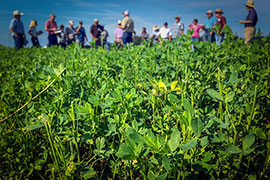
Dr. Rocky Lemus and Dr. Brett Rushing have been working on three projects specifically designed to provide producers better management strategies for alfalfa. They are researching the impact of potassium fertilization, harvest frequency, and grazing management in alfalfa.
A current study examines the application of poultry litter, an excellent potassium source, as well as a synthetic broadcast fertilizer that mimics the nutrient concentrations found in litter on three different varieties of alfalfa.
Lemus and Rushing are also conducting grazing trials in Newton, comparing alfalfa interseeded in bermudagrass, bermudagrass with a nitrogen application, and bermudagrass without fertilization. Thus far, they have found that the interseeded alfalfa/bermudagrass adds two weeks on the front end of the grazing season, providing an opportunity to increase animal weight gain. Cattle average daily weight gain was also higher in the alfalfa/bermudagrass forage compared to both bermudagrass treatments.
Since harvesting and storage of alfalfa can be a challenge in the hot, humid South, Lemus is also working with collaborators in other states to examine the use of commercial inoculants to help the forage convert plant sugars into organic acids and stabilize the forage for baleage or hay.
Overall, the research has shown that alfalfa is a great forage crop for Mississippi producers. However, there is still work to be done, particularly in refining harvest techniques that are suitable to the southeastern United States.
Read More
To Till or not to Till?
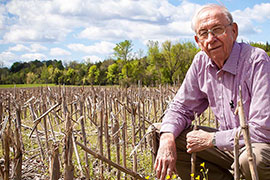
After four decades of research in corn, cotton, and soybeans, MAFES scientists have figured out a thing or two about conservation tillage. And research is helping north Mississippi farmers get seeds into the ground sooner with fewer equipment passes. The practice saves producers money with fewer passes across the field. It also helps protect the highly erodible soils in north Mississippi. A recent discovery has found that the practice also protects soil health.
Read More
Toxin-free Castor Would be Major Help to Industry
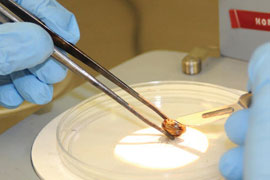
Castor oil is the highly desirable, plentiful product of castor beans. The oil is used to produce everything from cosmetics and paints to jet aircraft lubricants and certain plastics. The thick oil makes up 60 percent of the seed's weight. By comparison, high-oil corn or canola only produce about 25 percent oil by weight. Ninety percent of the oil is ricinoleic acid, a fatty acid found in large quantities only in castor oil. This acid has many industrial applications. MAFES scientist are trying to make it possible to grow the plant safely for commercial oil production in Mississippi. Castor seed meal, not the oil, contains ricin, a toxic protein that can become fatal if untreated in the body. To make castor a commercially viable U.S. crop, scientists are trying to discover a way to genetically modify the plant so that either the gene that produces the toxin is no longer expressed or the toxin is no longer produced. One of the challenges is that castor resists being transformed. The genetic modification process involves inserting a fragment of DNA foreign to the plant into the genetic code, where it must be accepted and become active. Everything from cotton to corn and soybeans has been genetically modified, but castor is much more difficult. The castor cells can be transformed, but you can't get whole plants to grow from the cells.
Read More
Turning Perennial Grass into Green Gasoline
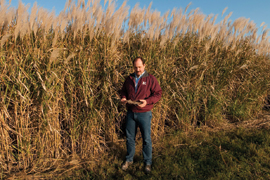
Plant scientist Brian Baldwin spent years developing a variety of giant miscanthus for use in biofuel production. Baldwin's discovery, an adaptation of a perennial grass native to Asia, is particularly suited to the Southeast's climate and soils, and it produces more biomass per acre than other bioenergy crops. MSU filed a plant patent application for the resulting variety, named Freedom, in 2010 and licensed it to Georgia-based Repreve Renewables LLC. Cool Planet Biofuels has used Freedom giant miscanthus to create gasoline, a breakthrough in the biofuels industry. In a pilot test, Cool Planet generated about 4,000 gallons of gasoline per acre of biomass using Freedom grown under nearly optimal crop growth conditions. Their process used air-dried, coarsely ground grass subjected to moderately high temperature and pressure to produce a ready-to-use gasoline, chemically identical to the petroleum-based fossil fuel. Baldwin also works to develop other crops suitable for biomass production, including oilseed crops, native and exotic grasses, and Sunn hemp, kenaf, and other fiber crops. For example, he is testing several switchgrass species for their ability to germinate on demand, which would allow farmers to increase yields of this biomass crop. Baldwin also examines the use of traditional crops as alternative energy sources. In one such project, he works to improve the sugar content of a sweet sorghum variety. In collaboration with the USDA-ARS, Baldwin is developing a cold-hardy sugarcane variety.
Under Cover
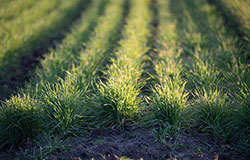
Cover crops provide an array of positive effects on any given cash crop system, affecting soil health, erosion, weed suppression, and more. Researchers at MAFES have long been working on a massive data-gathering project in efforts to understand how cover crops, when used in junction with other management practices, interact with cash crops. One study conducted this year evaluated whether or not two cover crops used together would result in greater biomass and more nitrogen availability for the corn planted in the late spring. Evidence supports that a mixture of cover crops is a viable method of increasing ecological stability and resilience for row crops.
Read More
Up and Down the Highway
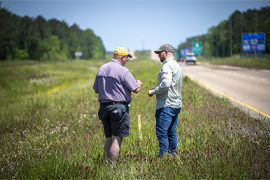
Mississippi Agricultural and Forestry Experiment Station (MAFES) scientists work with the Mississippi Department of Transportation, or MDOT, to keep highways right side of the right-of-way. This MAFES/MDOT partnership began over 30 years ago at the behest of the state legislature to develop cost-effective and efficient ways to maintain the vegetation on highway land masses. Mississippi State's understanding of vegetation and invasive weeds assists MDOT employees with the research and application needed to provide adequate upkeep on highways.
Read More
Using High Tunnels to Produce Crops Year-round
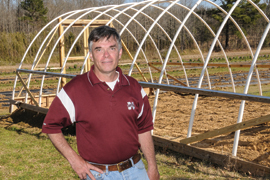
Don't tell assistant research professor Bill Evans that you can't grow tomatoes in January. Evans is raising warm-season vegetables, including organic tomatoes, cucumbers, and broccoli, throughout the winter using high-tunnel greenhouses, unheated hoop buildings covered in polyethylene. While the procedure used at the Truck Crops Branch Experiment Station in Copiah County is not ready for commercial production, Evans's project has led to the installation of dozens of high tunnels across the state. In another effort, Evans studies methods of building better soil structure during the low-production months of July and August to improve fall production.
What Lies Beneath
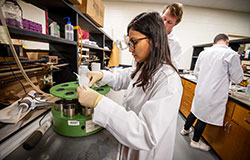
What lies beneath the surface of any soil is a living ecosystem with millions of bacteria and organisms working in concert to create the soil structure. Each soil structure differs in the effect it has on the crop growing there, just as each crop has an effect on the soil structure. MAFES researchers are assessing how soil health and structure is impacted by five different cover crops, three different fertilizer treatments, and two planting dates in a dryland soybean cropping system. The research is ongoing, but evaluating the different production practices and determining the most beneficial components of promoting a more consistent crop yield while also improving and sustaining soil health would be a win-win for farmers and the environment.
Read More
Where the Grass is Greener
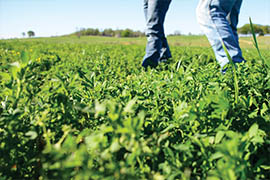
Dr. Rocky Lemus is on a mission: to help Mississippi producers become better forage managers. To accomplish his mission, he and Joshua White, manager of the MAFES Official Variety Testing program in forages, are developing a year-round grazing system. The grazing system, combined with the Official Variety Trials program in forages, and a newly developed forage testing program all work together to make Mississippians better forage managers for grazing cattle and hay production.
Read More
